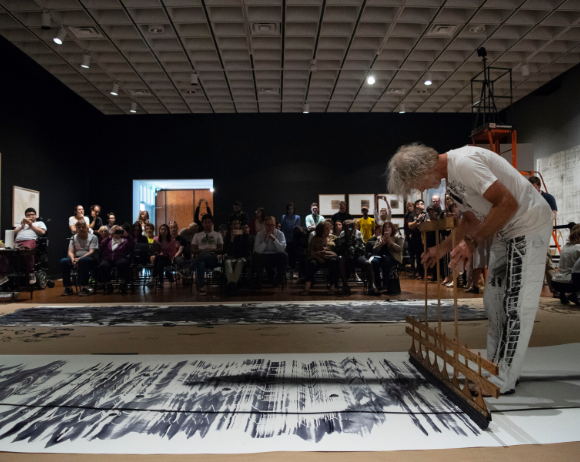DON'T BLAME IT ON ZEN

<< Lawrence Voytek performing "John Cage's STEPS: A Composition for a Painting" in the presence of Ray Kass and utilizing John Cage's brushes and tools at the Bob Rauschenberg Gallery at FSW in Fort Myers.
THE WAY OF JOHN CAGE & FRIENDS
LEARN MORE
READING
ARTICLES
The New Yorker: Searching for Silence
Walker Art Center, Minneapolis, MN 2017 Common Time exhibition
Reunion: John Cage, Marcel Duchamp, Electronic Music, and Chess
BOOKS
Where the Heart Beats: John Cage, Zen Buddhism, and the Inner Life of Artists, Kay Larson, Penguin Books, 2013
Allan Kaprow and Claes Oldenburg: Art, Happenings, and Cultural Politics, Robert E. Haywood, Yale University Press, 2017
Essays on the Blurring of Art and Life, Allan Kaprow and Jeff Kelley, UC Press, 2003
Love, Icebox: Letters from John Cage to Merce Cunningham, The John Cage Trust, 2019
VIEWING
ABOUT HAPPENINGS
Happenings, an event that combined elements of painting, poetry, music, dance, and theatre and staged them as a live action. The term Happening was coined by the American artist Allan Kaprow in the 1950s. The nature of Happenings was influenced by Italian Futurist performance, where the convention of “proscenium architecture” was assaulted, where the “actors” could consist of moving lights, machinery, and the audience, and where simultaneity and noise-music were developed. Happenings were also influenced by Dada's chance-derived assembly of found objects and events and by gestural painting, which was increasingly recognized as an event, as seen in Jackson Pollock's drip-painting technique-free-associative gestures he made while dripping, splattering, and pouring paint on canvases placed on the ground.
Happenings were briefly taken up by a number of American Pop artists, including Jim Dine, Claes Oldenburg, and Red Grooms. The term quickly became applied to a wide variety of live art events-from the painterly gestures of Japan's Gutai group to the street actions of Czech dissident Milan Knizak and his Aktual group. Happenings were also a part of the international avant-garde group Fluxus. Kaprow, Dick Higgins, and Al Hansen-all students at John Cage's composition class at the New School for Social Research in New York City-performed Happenings and were associated with Fluxus, as were other artists, such as Wolf Vostell and Carolee Schneemann.
Important precedents for Happenings included Oskar Schlemmer's Bauhaus experiments in abstract theatre, Antonin Artaud's Theatre of Cruelty and the Theatre of the Absurd, and the simultaneous actions coordinated by John Cage at Black Mountain College in 1952, which included the poet Charles Olson, the dancer and choreographer Merce Cunningham, and the artist Robert Rauschenberg, who went on to create a number of Happenings throughout the 1960s. In France, Yves Klein's choreographed installation and his sale of Zones of Immaterial Pictorial Sensitivity provided more examples of ethereal and time-based art, as did Georges Mathieu's theatrical demonstrations of painting, which he took to Japan.
[from Britannica, by Lisa S. Wainwright]
